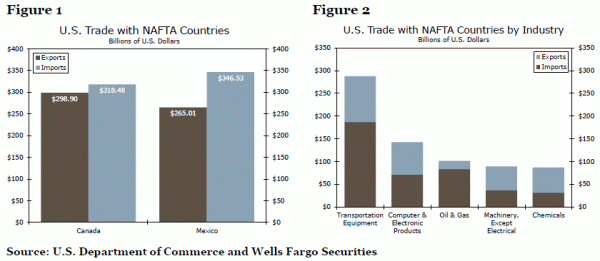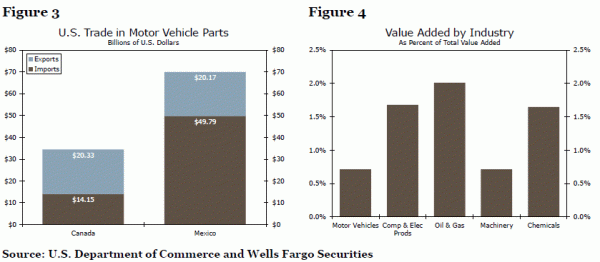Executive Summary
The U.S. Congress has not yet ratified the United States-Mexico-Canada Agreement (USMCA). If Congress does not ultimately ratify the deal, the United States could potentially withdraw from the North American Free Trade Agreement (NAFTA). A revocation of duty-free trade between the United States and its North American neighbors likely would not have meaningful macroeconomic effects for the U.S. economy, at least not in the short run, but it could lead to significant adjustment costs for individual industries, especially for the automotive industry.
Does No USMCA Lead to NAFTA Withdrawal?
Due to the surge of Central American migrants that have streamed into the United States to seek asylum, President Trump recently threatened to close the U.S.-Mexico border, or at least parts of it. Not only would a closure of the southern border impede the flow of people, but it would also have a detrimental effect on the flows of goods that are traded between the United States and Mexico. We addressed the potential economic fallout from a border closure in a recent report.1 However, the president subsequently softened his stance, so a closure of the U.S.-Mexico border does not seem to be an imminent possibility at present. But there is still an outstanding trade issue between the United States and Mexico that has not received much attention recently. Specifically, the USMCA, which was finalized and signed by the leaders of the three North American economies last autumn, has not yet been ratified.
The USMCA made some changes to NAFTA, which has governed the trade in goods and services among the three North American economies since 1994. One of the more notable alterations to NAFTA was the domestic content stipulations of automobile production. Under NAFTA, 62.5% of an automobile had to originate in one of the three NAFTA countries to qualify for duty-free trade. The USMCA raises this proportion to 75%, and at least 40% of a car must be produced by workers who make at least $16/hour. In addition, the USMCA would exempt Canada and Mexico, at least for the foreseeable future, from any tariffs that the United States may impose on auto imports later this year. Some of the dispute settlement procedures among the three signatories have been altered, the United States won expanded access to Canada’s dairy market and the countries agreed to review the overall USMCA deal after six years. However, the United States Congress has not yet ratified the USMCA, and passage remains uncertain. What happens if Congress does not ratify the deal?
Trade among the three North American economies at present continues to be governed by NAFTA rules. So if Congress does not ratify the USMCA, then the status quo (i.e., current NAFTA rules) would be maintained. But while negotiations were ongoing last year, President Trump had threatened to “rip up” NAFTA if the three countries could not reach agreement on a new trade pact. Any of the three signatories has the right to withdraw from NAFTA provided that it gives the other two partners six months’ notice. It is unclear whether the president can withdraw the United States from NAFTA without congressional approval. But if President Trump ultimately succeeded in withdrawing the United States from NAFTA because Congress does not ratify the USMCA, then trade between the United States and its two North American neighbors would no longer be duty free. How harmful would a revocation of duty-free trade be?
Would NAFTA Withdrawal Bring the U.S. Economy to Its Knees?
The United States exported roughly $300 billion of goods to Canada in 2018 while American imports from that country totaled nearly $320 billion (Figure 1). Two-way trade between the United States and Mexico also exceeded $600 billion last year.2 Together, Canada and Mexico accounted for one-third of the value of American exports of goods in 2018, and the United States received onequarter of its imports from its two NAFTA neighbors. Is short, Canada and Mexico were America’s second and third most important trading partners, respectively, in 2018.3
All sorts of goods flow across America’s northern and southern borders, but the five largest categories of exports and imports are shown in Figure 2. For starters, there is significant two-way trade in transportation equipment that was valued at nearly $300 billion in 2018. Although there is some trade in aerospace products, motor vehicles and parts account for the vast majority of trade in transportation equipment among the three North American neighbors. Computer & electronic products, oil & gas, machinery and chemicals round out the top five categories of two-way trade in goods. The five categories that are shown in Figure 2 suggest that the United States imports and exports significant quantities of intermediate goods (i.e., goods that are used in the production of other goods) from Canada and Mexico. Indeed, roughly one-half of the goods that the United States imports from its NAFTA partners are intermediate goods. Finished products comprise the other half.
A revocation of duty-free trade between the United States and its NAFTA partners would raise prices of the goods that the United States imports from Canada and Mexico. But a return to duties on imported goods from Canada and Mexico would likely not have much of a measurable effect on consumer price inflation. First, the amount of finished goods that the United States imports from its North American neighbors is equivalent to only 7% or so of the goods that American consumers buy. But with goods accounting for only one-third of U.S. consumer expenditures—services account for the other two-thirds—the effect on overall consumer prices would not be large. Moreover, the tariff rates that the United States levies on most imported goods are only in the single digits. A return to tariffs on finished goods originating in Canada and Mexico would likely not have a meaningful effect on the prices that American consumers pay for those products
U.S. exports to Canada and Mexico are also split roughly evenly between finished products and intermediate goods. Revocation of duty-free trade would raise the prices of finished goods that the United States sends to its North American neighbors, potentially reducing the quantities of those exports. But any associated hit to U.S. GDP growth would be miniscule because final spending by households, businesses and governments in Canada and Mexico accounts for only 2% of the value added that is created in the U.S. economy. In sum, there likely would not be significant macroeconomic effects, at least not in the short run, if the United States were to withdraw from NAFTA, although the inefficiencies that are associated with the price-distorting effects of tariffs could compound the negative macroeconomic effects over time. Moreover, there could be meaningful effects on individual industries from potential changes in trade flows, a topic to which we now turn.
The Importance of Two-Way Trade for the Auto Industry
The discussion above indicates that there is a significant amount of trade in intermediate goods between the United States and its NAFTA partners. Consequently, there could be meaningful effects on individual industries that use these goods in the production process. Consider the auto industry, where two-way trade in auto parts between the United States and its NAFTA partners totaled about $105 billion last year (Figure 3).4 Although American consumers could be the end purchasers of some of these automotive parts, we suspect that most of the parts are ultimately used in the assembly of finished cars and trucks.
Some auto parts reportedly cross borders multiple times. For example, a part may be manufactured in Canada and then shipped to the United States where it is used in the assembly of an engine. The engine is subsequently shipped to Mexico where it is used in the final assembly of a car, which is then sent back to the United States for sale to a consumer. If duties are applied every time auto parts cross the border, the cost of producing a car could be materially affected. Consequently, American auto manufacturers could decide to curtail operations in Canada and Mexico and instead produce the vehicle entirely in the United States. Although this move could lead to higher employment in the U.S. auto industry in the long run, it could also impose some significant nearterm costs on manufacturers as they close down operations in Canada and Mexico and build new production facilities in the United States.5
But the motor vehicle industry accounts for less than 1% of the value added that is created in the U.S. economy (Figure 4). The other four American industries with the most absolute exposure to two-way trade with Canada and Mexico also account for 2% or less of value added in the U.S. economy. In short, there probably would not be significant macroeconomic effects, at least not in the short run, from a revocation of duty-free trade between the United States and its NAFTA trading partners.
Conclusion
The leaders of the United States, Mexico and Canada reached agreement late last year on a trade deal that would reform NAFTA, but the U.S. Congress has not yet ratified the accord. If Congress does not ratify the USMCA, the Trump administration could potentially withdraw the United States from NAFTA. In that event, trade between the United States and its North American neighbors would no longer be duty free, as it has been over the past 25 years.
Revocation of duty-free trade likely would not have meaningful macro effects, at least not in the short run, on the U.S. economy. The United States levies single-digit tariff rates on imports of goods from most countries, so inflation likely would not rise significantly if duties would be imposed on Canadian and Mexican goods. Tariffs would raise the prices on American goods entering Canada and Mexico, but final spending in those two countries accounts for only 2% of the value added that is created in the U.S. economy. That said, the inefficiencies that are associated with the price-distorting effects of tariffs could compound the negative macroeconomic effects over time. Moreover, individual industries, especially the automotive industry, could be significantly affected if trade between the United States and its North American neighbors is no longer duty free















